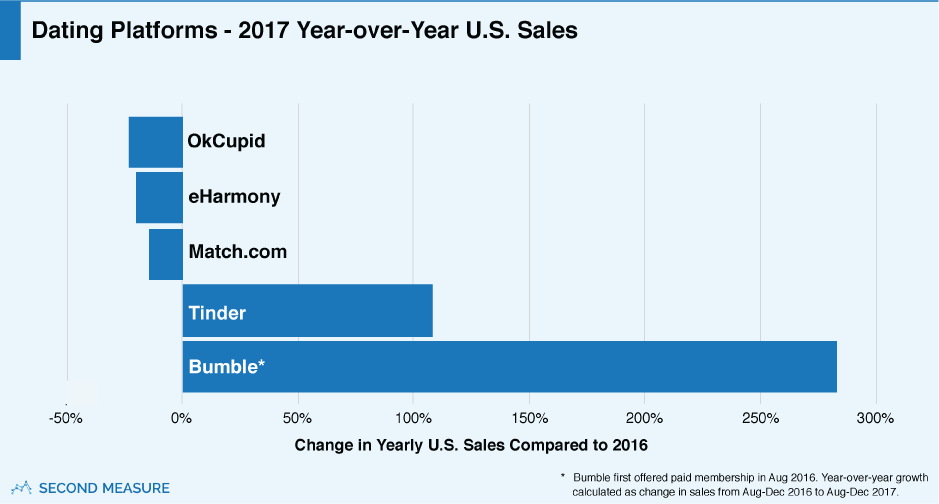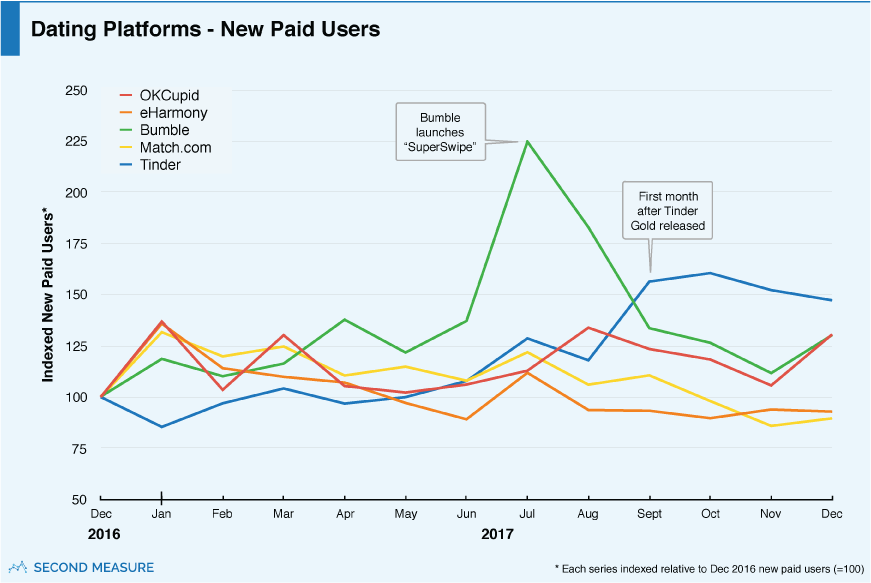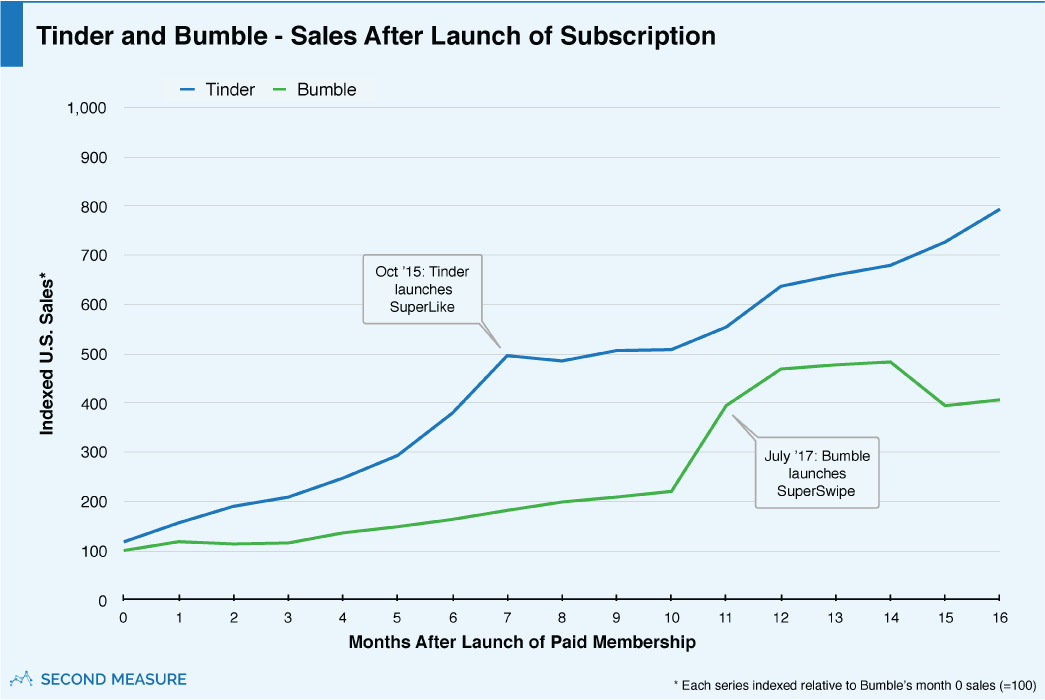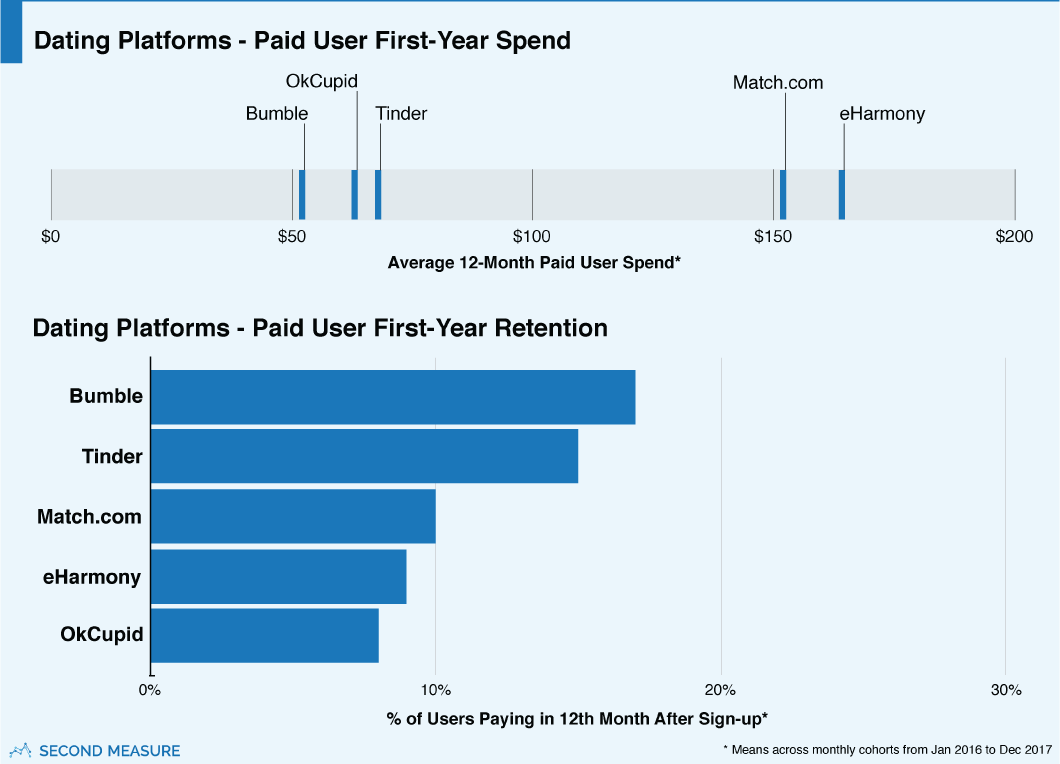NOTE: Bloomberg Second Measure launched a new and exclusive transaction dataset in July 2022. Our data continues to be broadly representative of U.S. consumers. As a result of this panel change, however, we recommend using only the latest posts in assessing metrics, and do not support referring to historical blog posts to infer period-over-period comparisons.
Couples celebrating Valentine’s Day are increasingly likely to have found each other online. Among those who’ve paid to use a dating platform, many turned to established sites, like veteran Match.com. But sparks are flying at Tinder and Bumble, where rapid matchmaking has led to rapid sales growth.
Tinder’s parent company, Match Group, owns several dating sites, including its namesake and OkCupid. On Match.com, anyone can create a profile, but to do more than just window-shop matches, users must pay for membership. Founded in 1995, Match.com has historically been the most popular dating platform. But as online daters increasingly break up with established sites, spending at dating apps Tinder and Bumble has taken off.

In 2017, Tinder’s yearly sales doubled compared to the previous year. At Bumble, spending throughout the last five months of the year nearly quadrupled compared to the same period in 2016, when paid features were first offered. This growth does not factor in iTunes transactions, which aren’t distinguishable in our data, but it does include credit and debit cards, PayPal, and Google Play. While Tinder and Bumble are quickly gaining popularity, dotcom-era sites prove less lucky in love (and sales).
Tinder users go for the gold
Tinder grew rapidly last year when, in the final days of August, it added a new membership tier—Tinder Gold. September saw a 33-percent jump in new paying members as users presumably flocked to Gold’s most-hyped feature: the ability to see who’s swiped right on you.

For established sites Match.com, eHarmony, and OkCupid, January was the biggest month for new paid users. This trend was also true of previous years, suggesting the holiday that drives most traffic to these sites is not Valentine’s Day—it’s New Years. July was also popular, showing a month-over-month increase in new customers across every platform.
“Super” add-ons lure paid users to trending apps
Newcomer Bumble offers several novel features that prod users to engage with each other. For instance, after two singles match on Bumble, the match expires after one day if no conversation starts up. For straight men and women, Bumble markets an additional twist—only the woman can initiate a conversation. This ladies-first approach may draw feminist accolades for Bumble, but a summer sales boost corresponds with the release of a less-original feature. Launched in July, Bumble’s “SuperSwipe” bears some striking similarities to Tinder’s “Super Like,” in both its use and impact on spending.
In its early days, Tinder started offering paid memberships in the form of Tinder Plus. Seven months later, it debuted the Super Like—a way to let another user know you’re really interested. Users are rationed one Super Like per day but can unlock additional Likes by paying for Tinder Plus. Tinder launched the Super Like in October 2015 and saw a 31-percent month-over-month increase in spending.

If imitation is the sincerest form of flattery, Tinder should be blushing. Bumble first offered the SuperSwipe in July 2017, one year after launching its paid memberships. Users were quick to observe that the 99-cent, in-app purchase greatly resembles Tinder’s Super Like. But despite criticism, Bumble’s sales increased by 79 percent the month that the feature hit the app.
Another way Bumble is similar to Tinder? Its customers.
CEO Whitney Wolfe Herd founded Bumble in collaboration with international-dating platform Badoo after she left Tinder on less-than-good terms. Like Tinder, Bumble is free to use, with options for in-app purchases and premium membership. And as of last quarter, 44 percent of Bumble’s paid users also spent with Tinder.
Match Group should be thrilled with its homegrown success, Tinder, but it appears to be hung up on the one that got away—reportedly offering $450 million for Bumble last year. Bumble rejected, but it may have just been playing hard to get. Recent reports say the company is up for sale with a valuation of $1.5 billion.
Putting a price tag on love
So how much are users shelling out on dating platforms? In their first year, paid users spend only $52 with Bumble, on average. But at eHarmony, that number triples, with new users averaging $162 in the same period. New subscribers can pay as much as $60 for a single month of eHarmony, but deeply discounted, multi-month packages help entice singles with commitment issues.

Since most of these users presumably aspire to remove themselves from the dating scene, retention is expectedly low across platforms. At 9 percent, eHarmony’s retention is one of the lowest among competitors, which aligns with its heavily marketed promise to efficiently match “compatible” users in long-term relationships. Bumble, however, is exploring ways around the expected dating-site churn. It recently added friendship and professional networking services, giving paid users a reason to stick around longer.
If our data leaves you wanting more, ask about starting a demo today.
Think you might be a good match for Second Measure? Good news, we’re hiring.
